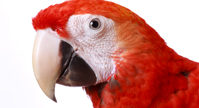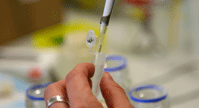Equine Gait (DMRT3)
Description:
Horse gaits are the various ways in which a horse can move, either naturally or ambling gait. Ambling gait is different types of gaits taught to horses by trainers for such things as races, trick riding and performances.
Horses have four naturally occurring gaits. In increasing order of speed, the four natural gaits of a horse are a walk, a trot, a canter and a gallop. Even though the canter is distinguished by having three beats, and the gallop has four beats some people considering the canter just a variation of the gallop.
A walk is typically defined as taking four hoof beats averaging 4-miles per hour and progressing in the following sequence: left hind leg, left front leg, right hind leg, right front leg, with a period of suspension.
A trot takes two hoof beats where the diagonal legs lift off and hit the ground at the simultaneously. A trot typically averages at a speed of 6-10 miles per hour.
A canter is a three-beat gait usually ranging between 10 and 15 miles per hour depending on the speed of the horse.
The fastest of these four speeds is the gallop which covers anywhere from 25 to 30 miles per hour.
Video Explaining Different Forms of Equine Gait
Standardbreds, which are the breed of horses in harness racing, either trot, in which a horse's legs move in diagonal pairs, or pace, where the foreleg and hind leg move in unison. Trotters must be trained not to break their gait at high speeds and gallop, which is a disqualification during a race.
Scientists in Sweden have recently discovered that DNA mutations in a single gene (DMRT3) that influences a horses ability to trot or pace and why some horses have a tendency to break their gait and go into a gallop. It's believed that this genetic variation happened more than 1,000 years ago and horses with this genetic difference would have had a smoother ride and thus been kept and bred.
Breeds That Benefit From Testing:
Trotters, Icelandic horses, Paso Fino, Tennessee walking horse, Standardbreds, Finnhorse
Other gaited breeds: presence of the A variant predisposes horses to perform alternative gaits. CC horses are three-gaited.
Additional Breeds That Can Benefit:
Other gaited breeds: presence of the A variant predisposes horses to perform alternative gaits. CC horses are three-gaited as well as American Saddlebred, Appaloosa Horse, Arabian Horse, Bashkir Curly, Miniature Horse, Paint Horse, Kentucky Mountain Horse, Quarter Horse, Mangalarga Horse, Tennessee Walking Horse, Morgan Horse, Peruvian Horse.
Test Results:
Animal Genetics has designed a method to identify SNPs that influence a horse's gait. The genetic test verifies the presence of the SNP mutation and presents results as one of the following. Horses can be genotyped for linked SNPs situated upstream of the DMRT3 nonsense mutation:
| Coldblooded Trotters | AA horses have natural ability for pace and excellent leg coordination and trotting technique at high speed. | |
| Icelandic Horses | AA horses have more natural ability to perform five gaits (walk, tölt, trot, gallop and pace). CA and CC horses are more likely to perform only four gaits (walk, tölt, trot and gallop). | |
| Standardbreds | Homozygous AA horses are more likely to preform better, earn more money and have higher breeding value for racing performance than CA and CC horses. |
Submit a Sample for Testing:
To submit a sample for testing please click on ORDER and download a sample submission form. Then follow the sample collection and submission instructions.
Cost per sample is $95.00. Please see our Equine Fee Schedule for all equine testing rates.
References:
J Hered. 2015 Nov-Dec;106(6):734-40. doi: 10.1093/jhered/esv062. Epub 2015 Aug 18.
Different DMRT3 Genotypes Are Best Adapted for Harness Racing and Riding in Finnhorses. Jäderkvist Fegraeus K1, Johansson L1, Mäenpää M1, Mykkänen A1, Andersson LS1, Velie BD1, Andersson L1, Árnason T1, Lindgren G2.
Anim Genet. 2014 Dec;45(6):908-9. doi: 10.1111/age.12228. Epub 2014 Oct 9.
Gaitedness is associated with the DMRT3 'Gait keeper' mutation in Morgan and American Curly horses. Jäderkvist K1, Kangas N, Andersson LS, Lindgren G.
Anim Genet. 2014 Apr;45(2):274-82. doi: 10.1111/age.12120. Epub 2014 Jan 21.
Worldwide frequency distribution of the 'Gait keeper' mutation in the DMRT3 gene. Promerová M1, Andersson LS, Juras R, Penedo MC, Reissmann M, Tozaki T, Bellone R, Dunner S, Hořín P, Imsland F, Imsland P, Mikko S, Modrý D, Roed KH, Schwochow D, Vega-Pla JL, Mehrabani-Yeganeh H, Yousefi-Mashouf N, G Cothran E, Lindgren G, Andersson L.










